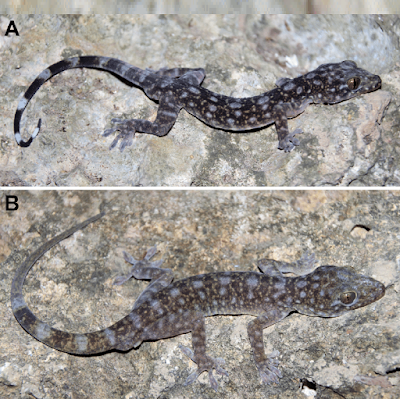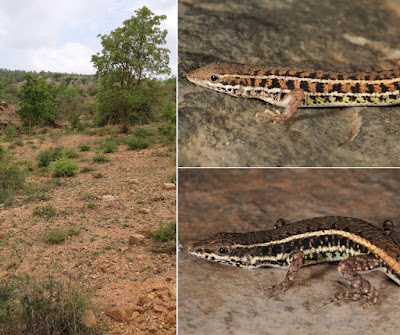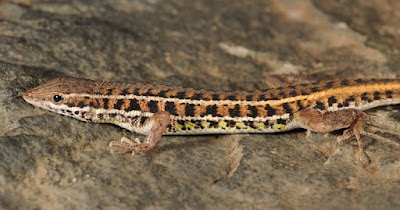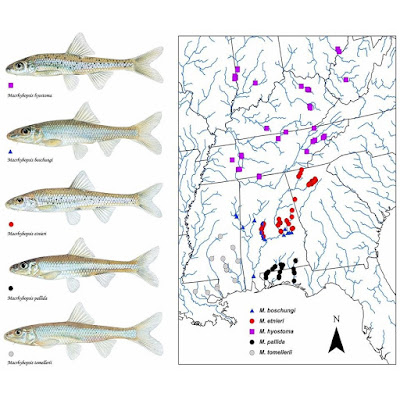[Most Recent Entries] [Calendar View]
Thursday, May 11th, 2017
| Time | Event | ||||||
| 1:40a | [Herpetology • 2017] Gekko nadenensis • A New Karst Dwelling Species of the Gekko japonicus Group (Squamata: Gekkonidae) from central Laos
Abstract A new species of the Gekko japonicus group is described from Khammouane Province, central Laos, based on morphological characters and molecular data. Morphologically, Gekko nadenensis sp. nov. is differentiated from the remaining congeners by a combination of the following characters: size moderate (SVL 61.0–77.1 mm); nares bordered with rostral; internasals absent; postmentals enlarged; interorbital scales between anterior corners of the eyes 28–30; dorsal tubercles absent; ventral scales between mental and cloacal slit 175–185; midbody scale rows 123–140; ventral scale rows 38–40; subdigital lamellae on first toes 13–15, on fourth toes 14–16; finger and toe webbing present at base; tubercles on dorsal surface of fore and hind limbs absent; precloacal pores six (3+3 or 5+1) in a discontinuous row in males, absent in the female; postcloacal tubercles 1 or 2; tubercles absent on dorsal surface of tail base; subcaudals distinctly enlarged; dorsal surface of body with greyish brown blotches. Molecular analyses demonstrated the new species is closely related to G. bonkowskii and G. thakhekensis, but separated from them by approximately 7% in genetic divergence as shown by a fragment of the mitochondrial ND2 gene. Keywords: Gekko nadenensis sp. nov., Khammouane Province, karst forest, morphology, molecular phylogeny, Reptilia, Laos
Gekko nadenensis sp. nov. Distribution. Gekko nadenensis sp. nov. is currently known only from the type locality in the karst forest of Nang Log cave, Naden Village, Gnommalath District, Khammouane Province, central Laos. Etymology. We name this species after its type locality, Naden Village, to underscore the importance of the limestone forest in terms of biodiversity and nature conservation. From this site another new gecko species (Cyrtodactylus rufford) was described recently (Luu et al. 2016). We suggest as common names: Naden Gecko (English), Kap Ke Naden (Laotian), and Naden Gecko (German).
Vinh Q. Luu, Thai Q. Nguyen, Minh D. Le, Michael Bonkowski and T. Ziegler. 2017. A New Karst Dwelling Species of the Gekko japonicus Group (Squamata: Gekkonidae) from central Laos. Zootaxa. 4263(1); 179–193. DOI: 10.11646/zootaxa.4263.1.10 | ||||||
| 9:01a | [Herpetology • 2017] A Phylogeny of Open-habitat Lizards (Squamata: Lacertidae: Ophisops) Supports the Antiquity of Indian Grassy Biomes
Abstract Aim: India is dominated by tropical grassy biomes (TGBs), traditionally considered seres or degraded forest, with low diversity relative to the restricted, ancestral wet zone. It is unclear if Indian grasslands and other open habitats are anthropogenically derived or native, old-growth habitats; without a clear timescale of grassland evolution. One way to understand grassland evolution is to study the diversification in taxa restricted to open habitats. We use a dated phylogeny of Ophisops to address questions related to the origin, diversification and inter-relationships of Indian and Saharo-Arabian Ophisops, and ultimately the origin of Indian grasslands and open habitats. Location: The Indian subcontinent; the Saharo-Arabian Realm. Methods: We generated up to 2736 base pairs of aligned sequence data (one mitochondrial, two nuclear genes) for Indian lacertids and reconstructed phylogenetic relationships using maximum likelihood and Bayesian inference. We use a fossil-calibrated timetree, diversification analyses and ancestral area reconstructions to test the hypotheses of origin and relationships with Saharo-Arabian Ophisops. Results: Ophisops is strongly supported as monophyletic, with a basal split into a large-bodied (LBC) and small-bodied clade (SBC). The Saharo-Arabian species are nested within the Indian species in the LBC. Species diversity in Indian Ophisops is grossly underestimated, with 26–47 candidate species. Ophisops began diversifying in the late Oligocene with significant rate shifts in the late Miocene-Pliocene and Pleistocene within the SBC. Main conclusions: Our results are consistent with an ancient origin of grassland taxa and TGBs in India. Ophisops is a dramatic example of overlooked cryptic diversity outside forests, with ~30 species where five were known. Ophisops dispersed into India from the Saharo-Arabian Realm in the Oligocene with a back dispersal in the Middle Miocene, a novel biogeographical pattern. Diversification in the SBC of Ophisops increased 8-fold during the global C4 grassland expansion. Indian TGBs are old-growth ecosystems that need urgent conservation attention.
Ishan Agarwal and Uma Ramakrishnan. 2017. A Phylogeny of Open-habitat Lizards (Squamata: Lacertidae: Ophisops) Supports the Antiquity of Indian Grassy Biomes. Journal of Biogeography. DOI: 10.1111/jbi.12999 How lizards revealed the millennia-old evolution story of India’s grasslands scroll.in/magazine/836758/how-lizards-re | ||||||
| 3:15p | [Ichthyology • 2017] Morphological and Genetic Evolution in eastern Populations of the Macrhybopsis aestivalis complex (Cypriniformes: Cyprinidae), with the Descriptions of Four New Species Abstract For many years the North American cyprinid fish Macrhybopsis aestivalis (common name: Speckled Chub) was regarded as a single widespread and morphologically variable species, occurring in rivers throughout much of the Mississippi Valley and geographically adjacent eastern Gulf slope drainages, west to the Rio Grande basin in Texas, New Mexico, and Mexico. Eisenhour (1997) completed a morphological study of western populations of the Speckled Chub, the results of which appeared thereafter in published form (Eisenhour 1999, 2004). He demonstrated the existence of five valid species west of the Mississippi River (aestivalis, marconis, australis, tetranema, hyostoma), of which the name aestivalis was shown to be restricted to the population occurring in the Rio Grande and the geographically adjacent Rio San Fernando system, in northeastern Mexico. Eisenhour (2004) considered populations throughout the middle Mississippi Valley and its major tributaries to be a single morphologically variable species (hyostoma), and he also indicated that populations of Macrhybopsis from eastern Gulf slope drainages may represent a complex of species. Genetic confirmation of Eisenhour’s conclusions regarding western species appeared in the publication by Underwood et al. (2003), who also showed that western populations of M. hyostoma, as presently recognized, are genetically much more complex than previously considered. Meanwhile, the present authors were involved in a companion study of eastern populations of Macrhybopsis, for which a genetic summary of the eastern Gulf coast species was published by Mayden & Powers (2004). Based on their findings, four species were recognized from southeastern drainages (identified as species A–D), although no formal taxonomic descriptions were included. Their genetic data, in combination with meristic, morphometric and other morphological data presented herein, form the basis for a revised classification of eastern Macrhybopsis populations, including formal descriptions of the four new species from eastern Gulf coast drainages. Keywords: Pisces, Cyprinidae, Macrhybopsis, new species, eastern Gulf slope drainages, genetics, morphology, biogeography Systematic accounts • Macrhybopsis hyostoma (Gilbert 1884) Shoal Chub Etymology. The species name hyostoma is derived from the words hyo (=hog) and stoma (=mouth), in reference to the underlying position of the mouth relative to the projecting snout. • Macrhybopsis boschungi Gilbert & Mayden sp. nov. Mobile Chub Etymology. Named for the late Dr. Herbert T. Boschung, Emeritus Professor of Biology at the University of Alabama, for his many contributions over the years to southeastern ichthyology in general and the state of Alabama in particular, including co-authorship of Fishes of Alabama (Boschung & Mayden 2004). It should be noted here that the vernacular name “Mobile Chub” used here differs from the name “Gulf Chub” applied by Boschung & Mayden (2004: 209; plate 21A). Considering its geographical distribution, we consider the former name to be more appropriate for the species. • Macrhybopsis etnieri Gilbert & Mayden sp. nov. Coosa Chub Etymology. Named for Dr. David A. Etnier, Emeritus Professor of Zoology at the University of Tennessee, for his many contributions to southeastern ichthyology and aquatic biology, including co-authorship of the definitive book on the fishes of Tennessee. • Macrhybopsis pallida Gilbert & Mayden sp. nov. Pallid Chub Etymology. The species name pallida is in reference to the generally pallid body pigmentation characteristic of this species. • Macrhybopsis tomellerii Gilbert & Mayden sp. nov. Gulf Chub Etymology. Named for Joseph R. Tomelleri, biological illustrator living in Leawood, Kansas, whose unsurpassed and meticulously rendered color illustrations of North American freshwater fishes have graced the pages of numerous scientific publications (including the present one), as well as books such as Fishes of the Central United States (Tomelleri & Eberle 1990) and Fishes of Alabama (Boschung & Mayden 2004). C.R. Gilbert, R.L. Mayden and S.L. Powers. 2017. Morphological and Genetic Evolution in eastern Populations of the Macrhybopsis aestivalis complex (Cypriniformes: Cyprinidae), with the Descriptions of Four New Species. Zootaxa. 4247(5); 501–555. DOI: 10.11646/zootaxa.4247.5.1 |
| << Previous Day |
2017/05/11 [Calendar] |
Next Day >> |














